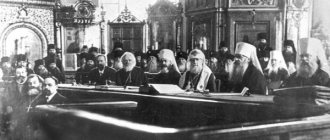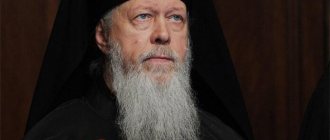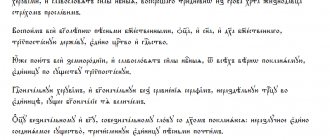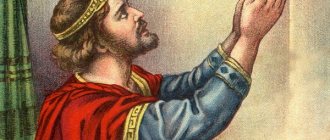The process of establishing patriarchy
Since 1448, the metropolitan in Moscow was considered autocephalous. However, the establishment of the patriarchate dates back to May 1589, when the Ecumenical Patriarch Jeremiah II, who served as Patriarch of Constantinople intermittently from 1572 to 1595.
Rice. 1. Patriarch Job.
During the negotiations, Patriarch Jeremiah II was under house arrest. Negotiations began in July 1588. The decision to create the patriarchate was confirmed by two councils in Constantinople, they were held in 1590 and 1593.
The royal throne in those years was occupied by Fyodor Ioannovich, the son of Ivan IV the Terrible, the last tsar from the Rurik dynasty. Boris Godunov played an important role in the creation of the patriarchate.
In the list of patriarchates of that time, Moscow was given fifth place, after Constantinople, Alexandria, Jerusalem and Antioch. The patriarchate existed in Russia until 1700. After the death of Patriarch Adrian in 1700, Peter I forbade electing a new one, and 20 years later he created the Holy Synod to manage the affairs of the church.
The actions of Patriarch Jeremiah were single-handed. They caused condemnation in the Middle East, for example, from the Patriarch of Alexandria. In 1590 this patriarch refused to sign the letter, but in 1593 his signature appeared there.
Rice. 2. Patriarch 1589.
Conditions of establishment
The patriarchate in the Russian state was established during the reign of Tsar Fyodor Ivanovich. He, according to many historians, was more of a nominal ruler. Real power was concentrated in the hands of the boyar Boris Godunov, who was married to the sovereign’s sister. Godunov is one of the most controversial figures in Russian history. At the same time, he is considered a statist, focused on strengthening the international role of the state on the world stage. Among the achievements of this person one can safely include the patriarchate and independence of the Russian Orthodox Church.
The concept of the Third Rome laid a certain ideological basis for such a process. It developed at the beginning of the 16th century. and viewed the Russian state as the custodian of the true Orthodox faith. The ideologists of this doctrine said that Moscow is the follower and heir of Rome and Constantinople. She is the Third Rome, and there can no longer be a Fourth.
First Patriarch – Job
Patriarch Job was born in the city of Staritsa on the territory of modern Tver region in 1525. In his youth, he studied at the school at the Staritsky Assumption Monastery. In 1556 he became a monk and instead of the worldly name Ivan took the name Job. In the 1570s, he held the position of archimandrite in the royal Novospassky Monastery in Moscow. In 1581-1586 he was Bishop of Kolomna and Archbishop of Rostov. In 1586 he took the post of Moscow Metropolitan, and from 1589 - Moscow Patriarch.
During the years of his patriarchate, the process of spreading Orthodoxy in the Volga region and Western Siberia took place, the printing of church books increased, St. Basil and Joseph of Volotsky were canonized. Under the impostor False Dmitry I, Job was sent into exile as a simple monk in the city of Staritsa. After the overthrow of the impostor, he was rehabilitated, but did not return to the patriarchal throne due to old age and died in his hometown in 1607. He was buried in the Staritsky Monastery and in 1989 he was canonized as a saint. In 2012, Patriarch Job was canonized by the Old Believer Church.
After Job, under the impostor False Dmitry I, Ignatius was patriarch for a short period. In 1606 he was defrocked and a few years later he left for the Polish-Lithuanian Commonwealth, where he accepted union with Catholicism. He was born in Cyprus in 1560 and died in 1640 in Vilna.
Rice. 3. Patriarch Ignatius.
History of the Patriarchate in Russia
From the moment of its formation and for many centuries, the Russian Orthodox Church was one of the metropolises subordinate to the Patriarch of Constantinople. As a representative of the church hierarchy, the Russian metropolitan exercised the authority of the Patriarch of Constantinople in his metropolis and was under his jurisdiction. In fact, he was the head of the national church of an independent state and therefore had greater independence in relation to Constantinople compared to other bishops subordinate to Constantinople.
Metropolitans who ruled the lands inhabited by Russians (both in times of a unified state and in times of fragmentation) were, as a rule, sent from Constantinople. They were chosen from the local church hierarchs, were usually Greeks, Serbs, Bulgarians, etc., and came to Russia without knowing either the language or the realities of this land. As a rule, this was explained by the fact that the Russian clergy is poorly educated, poorly versed in theological issues, and therefore needs the help of enlightened foreigners. In turn, the Russian princes, for obvious reasons, sought to transfer the management of the metropolis into the hands of their compatriots, the Russian hierarchs.
For the first time this was possible to do in the 11th century, when in 1051 the first Russian by birth, Metropolitan Hilarion, occupied the Kyiv department.
He was recommended for this position by a council of Russian bishops and approved by the Patriarch of Constantinople. However, this did not become the rule - for the most part, the Russian church was still ruled by Greeks sent from Constantinople, and only occasionally did the Russian clergy manage to “promote” one of their own.
This was also due to the fact that the Russian metropolis was considered a “tidbit” and getting here was considered a rare success, so naturally they promoted their own people. She was one of the richest, if not the richest. It is not for nothing that Patriarch Joseph of Constantinople, shortly before the Council of Florence, proposing to open a joint council with Catholics not in Italy, but in Constantinople, said: “Whoever comes here from the West will not need our help. But even if this required up to a hundred thousand asprors, it could have been collected from the bishops. The Russian Metropolitan alone will bring such a sum.”
After the Tatar-Mongol invasion, the situation was further aggravated by the fact that the Russians found themselves to be a divided people - part of the Russian lands fell under the rule of the Tatar Golden Horde, part ended up in the Grand Duchy of Lithuania, and another small piece - Galicia - went to Poland. Since Moscow became the residence of the Russian metropolitan after the invasion, the Lithuanian and Polish rulers feared “Moscow influence” on their subjects and sought to get their own, separate metropolitan. Sometimes they succeeded (during the weakening of Constantinople, metropolitans were already openly installed “for bribes”), there were periods when in Rus' there were two, or even three metropolitans, each of whom laid claim to supreme power.
Simultaneously with the strengthening of Moscow, when it began to de facto turn into an independent state, the desire for church independence began.
However, it took shape de facto only after the Council of Florence. Let us remember that at that time Byzantium was in a desperate situation - it had lost almost all its lands and the Turks were almost at the walls of Constantinople. The Greeks appealed for help to Europe, to their fellow Christians, but the Catholics, taking advantage of the plight of the Orthodox, demanded a preliminary settlement of all differences between the two Christian denominations, and for this purpose the Council of Florence was convened. The Greek Isidore, who had just been appointed Metropolitan of Kyiv and Russia, came to him from Russia. Isidore turned out to be an ardent supporter of union (union) and after the Orthodox accepted all the demands put forward by the Catholics at the council, he returned to Russia with the news that the Western and Eastern branches of Orthodoxy had united.
However, in the Grand Duchy of Moscow, where the “Latin heresy” was always considered a terrible sin (even Muslims were treated with more complacency than Catholics), he did not find understanding. A council of Russian bishops, urgently convened by Prince Vasily the Dark, decisively rejected the union, and Isidore was taken into custody. No one understood what to do with a church hierarch of such a high rank, so a year later Isidore was given the opportunity to escape, and he immediately took advantage of it, leaving through Lithuania to Italy, where the Pope soon made him a bishop.
And the Russian hierarchs, after consulting, elected Bishop Jonah of Ryazan as metropolitan.
Jonah did not go to establish himself in Constantinople - there was no one to establish himself with.
The imperial throne there was occupied by John VIII, who signed the union, and the patriarchal throne was occupied by the Uniate Gregory Mamma. After this, the subordination of Byzantium was ended forever, and Russian metropolitans were confirmed only by a council of Russian church hierarchs.
True, the independence of the Russian Orthodox Church coincided with its split. In 1458 in Rome, the Uniate patriarch ordained Gregory, a student of Isidore, as metropolitan of the Russians, who soon left for Kyiv, because the power of the Moscow princes did not extend to the Lithuanian and Polish lands. In 1460, Gregory sent an embassy to Moscow and demanded the removal of Metropolitan Jonah. The subsequent categorical refusal formalized the division of the metropolis into Kyiv and Moscow.
In 1453, Constantinople fell and the Byzantine Empire disappeared forever from the world map.
After this, the Moscow Kingdom, which had barely gained independence, turned out to be the only independent Orthodox power on the planet.
And even though the Byzantine clergy rejected the Florentine Union soon after its conclusion, the authority of the local church and the trust in it in Rus' were significantly undermined. Russian bishops even decided in 1480 not to admit Greeks to episcopal sees.
Despite the fact that in fact the Russian Church gained complete independence, according to the canons of the ancient church, it was impossible to legally formalize its independence - the patriarch could only be in an independent country. And although the Grand Duchy of Moscow was, in fact, independent since the time it stood on the Ugra under Ivan III, sovereignty was not formalized. Only when in 1547, according to the Byzantine rite, his grandson Ivan IV, the future Terrible, was crowned king, the last formal obstacle disappeared.
The patriarchate was introduced during the reign of Ivan IV's son, Fyodor Ivanovich.
It happened like this. In 1586, Patriarch Joachim of Antioch came to Moscow. He came to ask for money for the needs of his co-religionists who found themselves “under the Turks” (the Eastern patriarchs were then almost called “beggars” to their faces). Deciding to take advantage of this, the tsar (or rather, Boris Godunov, who ruled for him) declared that he wanted to establish “the highest patriarchal throne” in Moscow. Patriarch Joachim volunteered to resolve all issues with other patriarchs (according to canonical rules, when establishing a new patriarchate, the participation of all eastern patriarchs is necessary).
Two years later, Patriarch Jeremiah of Constantinople arrived in Russia. Everyone expected that he had brought with him the resolution of the Ecumenical Council on the establishment of the patriarchate in the Russian state. However, the guest, as it soon became clear, not only had arrived “empty,” but also openly extorted money, refusing to bless the establishment of the Moscow patriarchal throne. Realizing that it was possible to accept penniless eastern hierarchs indefinitely, Jeremiah was given strict conditions - he would not be released from Russia until he elevated the then Metropolitan Job to the patriarchal throne. And the consent of other patriarchs, they say, can be formalized retroactively.
And so it happened -
On January 26, 1589, Jeremiah approved Job as patriarch, and two years later Moscow received a letter signed by three patriarchs, 42 metropolitans and 20 bishops, approving the patriarchate in Russia.
True, they cheated a little here too - according to the agreement, the Moscow patriarch was supposed to occupy third place, after the Patriarchates of Constantinople and Alexandria, but in the charter he was given only fifth.
Russia received the patriarchate, and from now on the ritual of ordaining the Patriarch of Moscow took place in the Assumption Cathedral of the Moscow Kremlin. The order of delivery was as follows. On behalf of the tsar or the guardian of the patriarchal throne, letters of death of the saint were sent to the highest church hierarchs and abbots of large monasteries. On the appointed day, those invited appeared in the Kremlin in the Golden Chamber and the Tsar opened the cathedral. The patriarch was elected by lot: the king named six candidates, pieces of paper with their names were doused in wax, sealed with the royal seal and sent to the church where the council was meeting. The lots were placed on the panagia (breast icon of the Mother of God) of the deceased patriarch and taken out one by one until only one remained. It was handed over unopened to the king, who named the name of the new patriarch.
To the first patriarch, Jonah (patriarch from 1589 to 1607)
, had an unenviable fate. A terrible misfortune began in Russia - the Time of Troubles. The Patriarch firmly opposed False Dmitry the First and anathematized him. Having seized power, False Dmitry displaced Job and sent him to Staritsa, where he soon died. Without waiting for his death, False Dmitry independently appointed a new patriarch - Archbishop Ignatius of Ryazan, a Greek who had previously occupied the see in Cyprus.
The Russian Orthodox Church does not recognize Ignatius as a patriarch; after the overthrow of False Dmitry, he was defrocked and exiled to the Chudov Monastery.
Hermogenes (1606–1612) was elected second patriarch
, former metropolitan in Kazan. His patriarchate fell on the Time of Troubles, and his fate also cannot be called enviable - he was captured by the Poles who entered Moscow, who imprisoned him in the Chudov Monastery, where they starved him to death.
From the moment of the death of Hermogenes, for seven years the Russian Church remained without a patriarch. And only after the end of the Time of Troubles a new one was elected. Philaret (1619–1634), who returned from Polish captivity.
, father of the newly elected Tsar Mikhail Romanov. This was almost the highest rise of patriarchal power. Filaret, in the world boyar Fyodor Nikitich Romanov, a representative of one of the most noble families of the country, which has now become royal, was a statesman by God's grace - it was not for nothing that he was once forcibly tonsured a monk by Boris Godunov, who feared competition. He was the de facto ruler of the country during the first years of the reign of Mikhail Romanov, it was he who pulled the country out of the terrible consequences of the Time of Troubles.
He even had the same title as the tsar - “Great Sovereign.”
The next two patriarchs are Joasaph (1634–1640)
and
Joseph (1640–1652)
- were much less prominent figures, did not occupy such a high position and did not bear the title of great sovereign.
But Nikon (1652–1666)
- one of the most prominent figures in this post. A man who made an incredible career (from the son of a Mordovian peasant to the great Russian sovereign, he was able to carry out his famous reforms only because he was able to concentrate in his hands power that almost exceeded that of the Tsar). This, without a doubt, was the peak of the influence of the patriarchs on the fate of the country. And it was precisely with this that Nikon almost destroyed the patriarchate as a phenomenon. Tsar Alexei the Quiet, not wanting to share power (in essence, cede it to the patriarch), stopped obeying Nikon. In retaliation, he defiantly announced that he was leaving the patriarchate, and in 1658 he retired to New Jerusalem, hoping that he would be immediately called back.
They didn't call.
And when he tried to return to Moscow in 1664, they didn’t let him in. And in 1666, the Council of Bishops, which was attended by the Patriarchs of Antioch and Jerusalem, deposed Nikon, depriving him of the patriarchate. This is the only patriarch in our history who was legally sent “in retirement.” But the power of this man’s charisma was so great that when in 1681 the new Tsar Fyodor Alekseevich allowed Nikon, who had been exiled to the Kirillo-Belozersky Monastery, to return to Moscow, negotiations simultaneously began about the possibility of his restoration to his former holiest dignity. But, alas, on the way to Moscow, former Patriarch Nikon died.
Although subsequent patriarchs Joasaph II (1667–1673), Pitirim (1673), Joachim (1673–1690)
and
Adrian (1690–1700)
did not possess even a hundredth part of Nikon’s power, the tsarist government could not help but remember how it almost fell out of business overnight. They began to fear the patriarchs, and as soon as the next tsar, Peter Alekseevich, came into power, he abolished the patriarchate.
After the death of Adrian, Peter first personally installed the Ryazan Metropolitan Stefan Yavorsky at the head of the church with the title of locum tenens of the patriarchal throne. And soon after that, he replaced the patriarch with the Spiritual College (Holy Governing Synod) headed by the chief prosecutor - a secular official appointed by the emperor and responsible to the powers that be. The Church actually lost its independence and became one of the state departments that were under the constant control of the authorities.
For more than two centuries, the Holy Synod remained the highest church and government institution in Russia.
Conversations about the restoration of the patriarchate never died down, but especially intensified during the reign of Nicholas II - with the steady decline in the authority of the church in the eyes of the people, something had to be done. But Nicholas, famous for the fact that he preferred not to solve all the most pressing issues, but to postpone them until later, behaved in his usual way - he delayed in every possible way the convening of the Holy Council demanded by the hierarchs and flock. As a result, it met only after the February Revolution, when the Holy Synod addressed the archpastors and pastors of Russia with a message saying that with the changed political system, “the Russian Orthodox Church can no longer remain with those orders that have outlived their time.” The local cathedral of 1917–1918 opened on the feast of the Dormition of the Virgin Mary and was the longest in the history of the Russian Church. It was there that the patriarchate was restored, and Tikhon (Belavin) (1917–1925)
.
This man, who came to the post of Metropolitan of Moscow from the post of Archbishop of Aleutian and North American, had perhaps the most difficult share.
In some ways, the first patriarch elected after a long break repeated the fate of the first Russian patriarch Jonah. Almost immediately after the election - the Great Troubles. For Tikhon, there is practically no gap at all - the elder of the Zossimov Hermitage Alexy in the Cathedral of Christ the Savior took out a lot on which was the name of Tikhon on November 5, 1917, the day after the armed detachments of the Bolsheviks finally captured Moscow. Jonah was deposed by an impostor, Tikhon was also forced more than once to renounce the patriarchate, and attempts were made on his life more than once. The main focus of the new patriarch’s activities was the search for ways to at least somehow regulate relations between the church and the newly formed Soviet state.
After his death, there was no question of electing a new patriarch - priests were deliberately persecuted throughout the country.
We should not forget about the movement of “renovationists” - a movement in the Russian Orthodox Church that arose after the February Revolution, demanding renewal of the church, democratization of governance and modernization of worship. This movement, which opposed the leadership of the church by Patriarch Tikhon, declared full support for the new regime and its reforms, from 1922 to 1927 was the only Orthodox church organization officially recognized by the state authorities of the RSFSR, and enjoyed the recognition of other local churches.
All locums appointed by Tikhon were arrested and exiled, and therefore, at the end of 1925, Metropolitan Sergius (Stragorodsky)
. A year later, Sergius was arrested, and when released in the spring of 1927, he formed a temporary synod and, together with it, published a declaration on July 29 in the Izvestia newspaper, in which he called on all Orthodox Christians to be law-abiding “citizens of the Soviet Union” and, “leaving their political sympathies at home, to bring There is only faith in the church."
It was this declaration that was the main obstacle to unification with the Russian Orthodox Church abroad - the “foreigners” interpreted “Sergianism” as a “heresy of conformity.”
But it was the “conformist” Sergius (together with Metropolitans Alexy (Simansky) and Nikolai (Yarushevich)), and not the obliging Renovationists, who received Stalin on December 4, 1943.
Perhaps because in 1941, on the very first day of the war, Metropolitan Sergius wrote a message to his flock, in which he blessed the believers to defend their homeland and called on everyone to help the country’s defense. It was at this meeting that Metropolitan Sergius announced the church’s desire to convene a council to elect a patriarch, to which the head of government replied that there would be no obstacles on his part.
The Council of Bishops took place in Moscow on September 8, 1943, and on September 12 the newly elected Patriarch Sergius was enthroned. With this began the revival of the Russian Orthodox Church, the “renovationists” began to join the legalized Moscow Patriarchate.
True, Sergius did not have to be Patriarch for long - on May 14, 1944, he died.
His successors - Alexy I (Simansky) (1945–1970)
and
Pimen (Izvekov) (1970–1990)
- were engaged in streamlining the relationship between the church and the Soviet state, restored the relationship of the Russian Orthodox Church with other autocephalous churches, and resumed the publishing and educational activities of the Moscow Patriarchate.
This, of course, was not easy, but the lot of the fifteenth patriarch - Alexy II (Ridiger) (1990–2008)
- turned out to be much heavier. He had to rebuild relations with the new, radically changed government, revive thousands of new churches and monasteries, deal with religious unrest (schisms in Ukraine, Moldova and Estonia), aggravation of Orthodox-Catholic relations, and somehow respond to the unprecedented intensification of the activities of various sects .
Today Alexy II passed away. The entire Orthodox (and not only) world is waiting to see who will be the sixteenth.
The situation in the Orthodox world
The establishment of the patriarchate in Russia was preceded by a difficult situation in the Christian world. Back in the 14th century, Byzantium fell and Constantinople was captured. After this, most of the eastern churches became dependent on the Turkish sultans. Russia remained virtually the only independent Orthodox state in the world.
Since then, the Christian East has often looked at Russia as the main defender of Orthodoxy.
The meaning of the patriarchate
What significance did the establishment of the patriarchate have for Russia, and why did Boris Godunov and the rulers of that time strive to achieve this? Let's try to answer this question.
The historical significance of the establishment of the patriarchate in Russia lies in the receipt of official independent status for the Moscow Metropolis from the Greek Church. The Russian Church acquired a unique and exclusive role in the Orthodox world of that time, and it continues to this day. It became more numerous and influential, and most importantly, it became closely connected with the only Orthodox state in the world at that time.
For many it was obvious that sooner or later the year of the establishment of the patriarchate in Russia would come. Previously, this was hampered by very tense and difficult relations with the Patriarchate of Constantinople, which did not want to recognize the authority of Rus', seeing how quickly all influence in the Orthodox world was passing to it. Obtaining the consent of the Eastern Patriarchs was a prerequisite; without it, it was impossible to independently proclaim the Metropolitan Patriarch of Moscow. As a result, historical circumstances turned out well; now, if you are asked to indicate the date of the establishment of the patriarchate in Russia, you can answer that it was February 5, 1589.
The role of Boris Godunov
The date of the establishment of the patriarchate in Russia occupied an important place in the history of the Russian Orthodox Church. In fact, its updated history began from then on.
Godunov’s role in this became one of the key ones. It is worth noting that not everyone abroad reacted positively to this decision. The reaction in the Orthodox East was different.
In particular, the authoritative theologian Meletius Pigas, who became patriarch in Alexandria in 1590, was categorically against it, challenging the legality and legality of this decision. He tried to prove that the decision that Jeremiah made in the Russian capital was due to cunning and violence on the part of the Russians, which is confirmed by numerous historical studies.
It is worth noting that by 1593 he too had resigned himself, signing the charter establishing the patriarchate in Russia. The results of this can still be observed today, when Russia remains one of the key Orthodox countries in the world.
Of great importance in this is the Charter of 1589, which declares the concept of “Moscow is the third Rome,” previously also known from other sources.
It is worth emphasizing that the authenticity of the letters confirming the establishment of the patriarchate in Russia was repeatedly questioned by contemporaries and many descendants. In the 20th century, graphological examinations were carried out, according to which most of the signatures in the 1590 charter were forged. At least 70 of the 105 signatures were not genuine.
At the same time, such violations and forgeries could not be identified in the charter of 1593.
Rapprochement with Boris Godunov
In the mid-1580s, Job became close to one of the tsar's favorites, Prince Boris Godunov, who subsequently actually seized power in the country. It was with the assistance of Godunov that the patriarchate was established in Russia in 1589. By that time, Job was already the Metropolitan of Moscow and the main contender for this position.
Having taken the place of the head of the Orthodox world, Job invariably supported Godunov in all his affairs and endeavors. Among the important events that his reign is remembered for, it is worth highlighting the canonization of St. Basil the Blessed, the spread of Christianity in the Volga region and Siberia, which Ivan the Terrible conquered. During the reign of Boris Godunov, these territories were finally and officially annexed to Russia.
The year of the establishment of the patriarchate in Russia became an important starting point for the growth of the country's influence in the Orthodox world. The number of printed liturgical books grew, and some neighboring countries even specifically turned to Russia for missionaries who were supposed to teach people the Orthodox faith. In particular, the Georgian Tsar Alexander made such a request.
The establishment of the patriarchate in Russia took place in 1589, shortly after the death of Ivan the Terrible, one of the most influential and cruel rulers at that time. The Patriarch of Moscow appeared at a time when the weak and sickly Fyodor Ioannovich, who was the complete opposite of his father, sat on the throne. The authorities needed to take urgent measures to regain popular respect.
Joachim's visit
Knowing about Godunov’s ambition, one cannot help but admit that he was a true patriot and statesman. He carried out a number of important reforms, the establishment of the patriarchate was one of them. All of them were aimed at strengthening the power and international influence of the Russian state.
The first step in establishing the patriarchate was the organization of the visit of Patriarch Joachim to Moscow in 1586. He was greeted with great honor. This was the first time that the Eastern Patriarch came to Moscow.
During this visit, Godunov showed miracles of sophisticated diplomacy. Joachim was received with honor in the Kremlin; he was expecting a meeting with the Moscow Metropolitan Dionysius, but he was clearly in no hurry to see him. At the same time, the guest was invited to dinner with the king, which was incredibly honorable. While waiting for the meal, he was sent to the Assumption Cathedral of the Moscow Kremlin, where Dionysius was performing a service. Obviously, everything was carefully thought out. As soon as Joachim entered the cathedral, Dionysius was the first to bless him, this was unheard of insolence. His indignation fell on deaf ears; moreover, he was not even invited to go to the altar. The Patriarch stood at the back pillar of the Assumption Cathedral throughout the service.
The meaning of the action, which is believed to have been directed by Godunov, was to make it clear to Joachim that the Greek patriarchs come to the Russian Church exclusively for help and support, finding themselves in the role of supplicants. The Eastern patriarchy was clearly asked to think about correcting this injustice.
After this scandal, Joachim did not want to see Dionysius; further negotiations were conducted by Godunov himself. The guest was clearly not ready for the proposal to establish a patriarchate in Moscow, moreover, he could not make a decision on his own, but promised to consult with other Eastern patriarchs. The final word remained with Constantinople.







